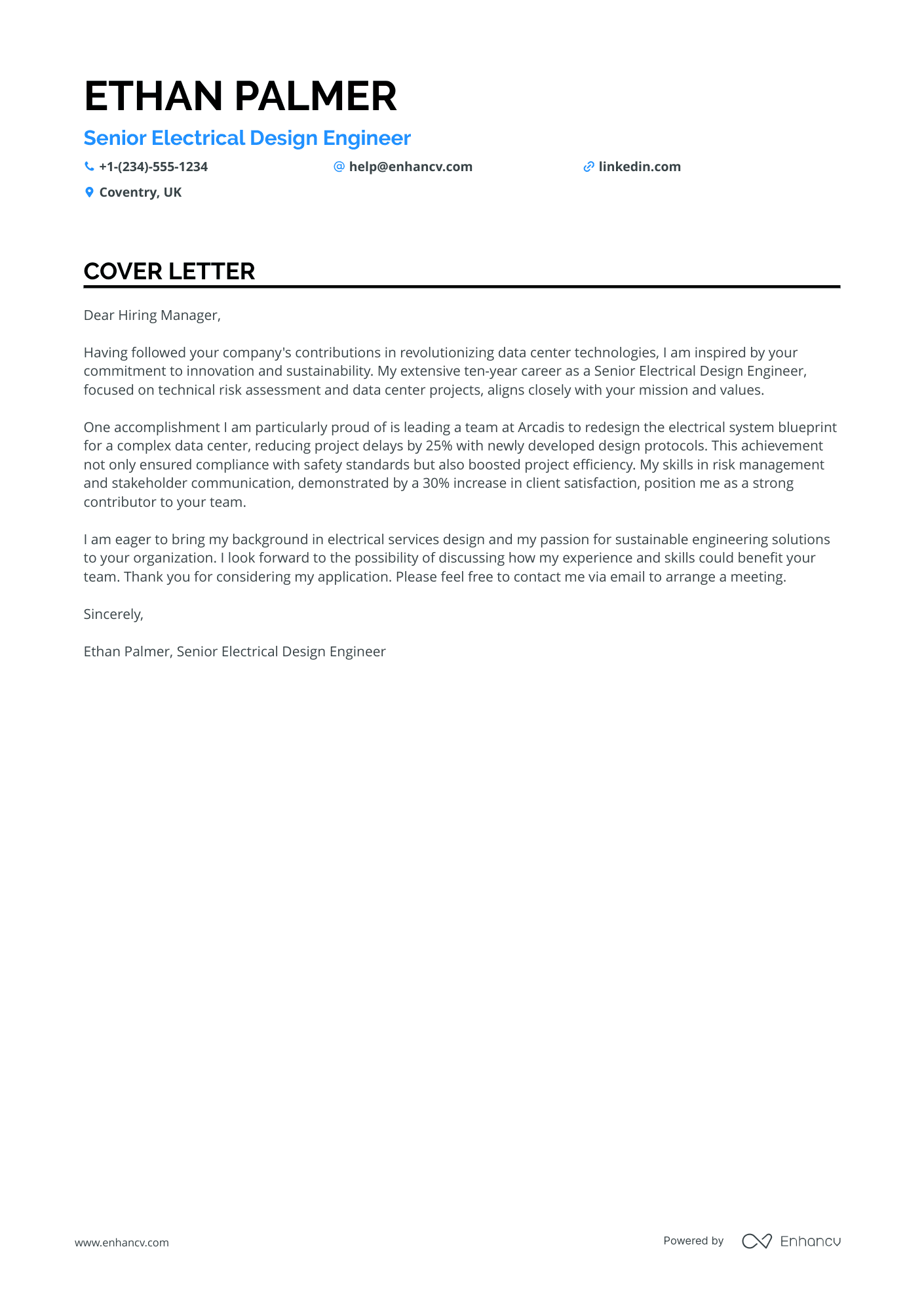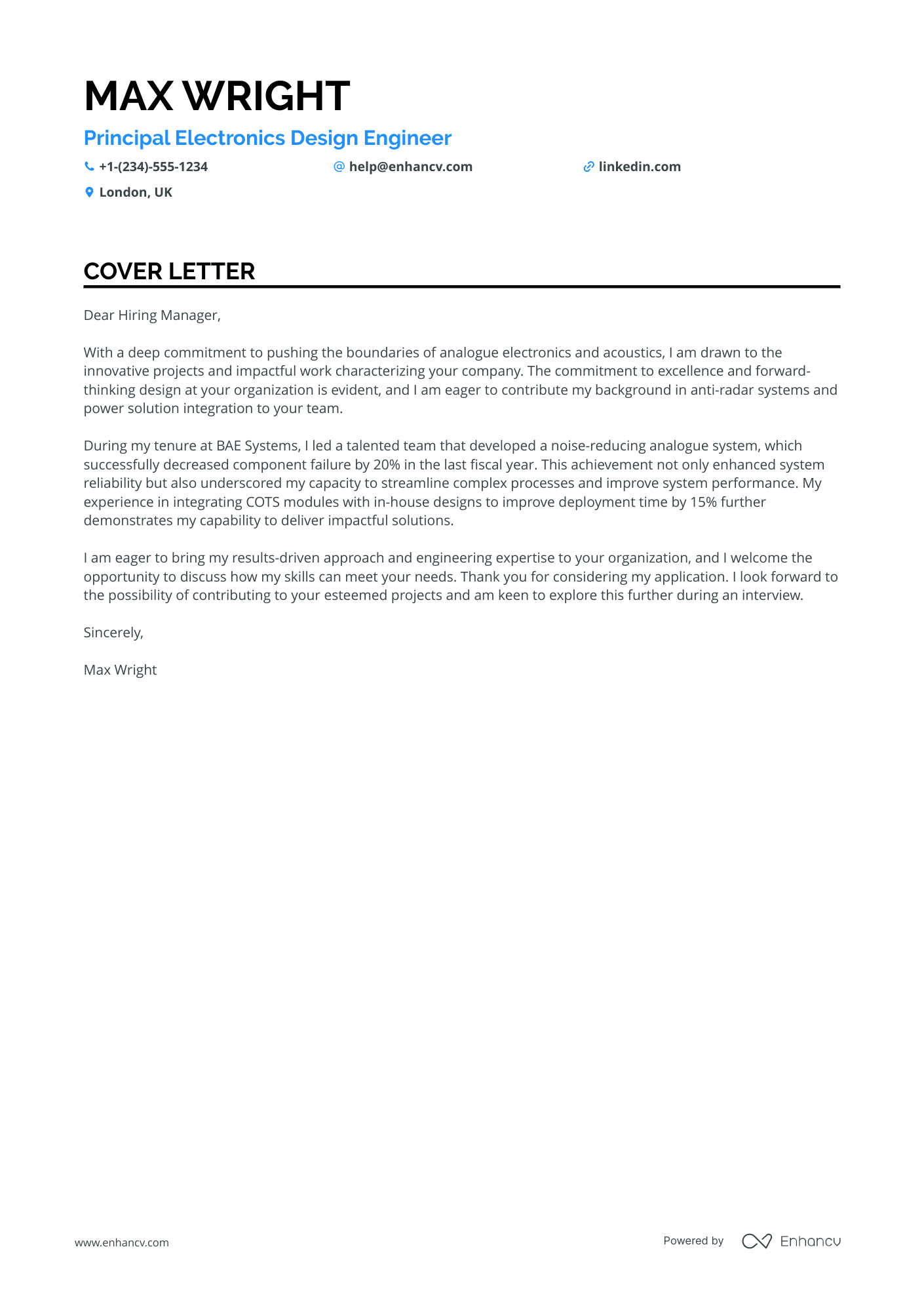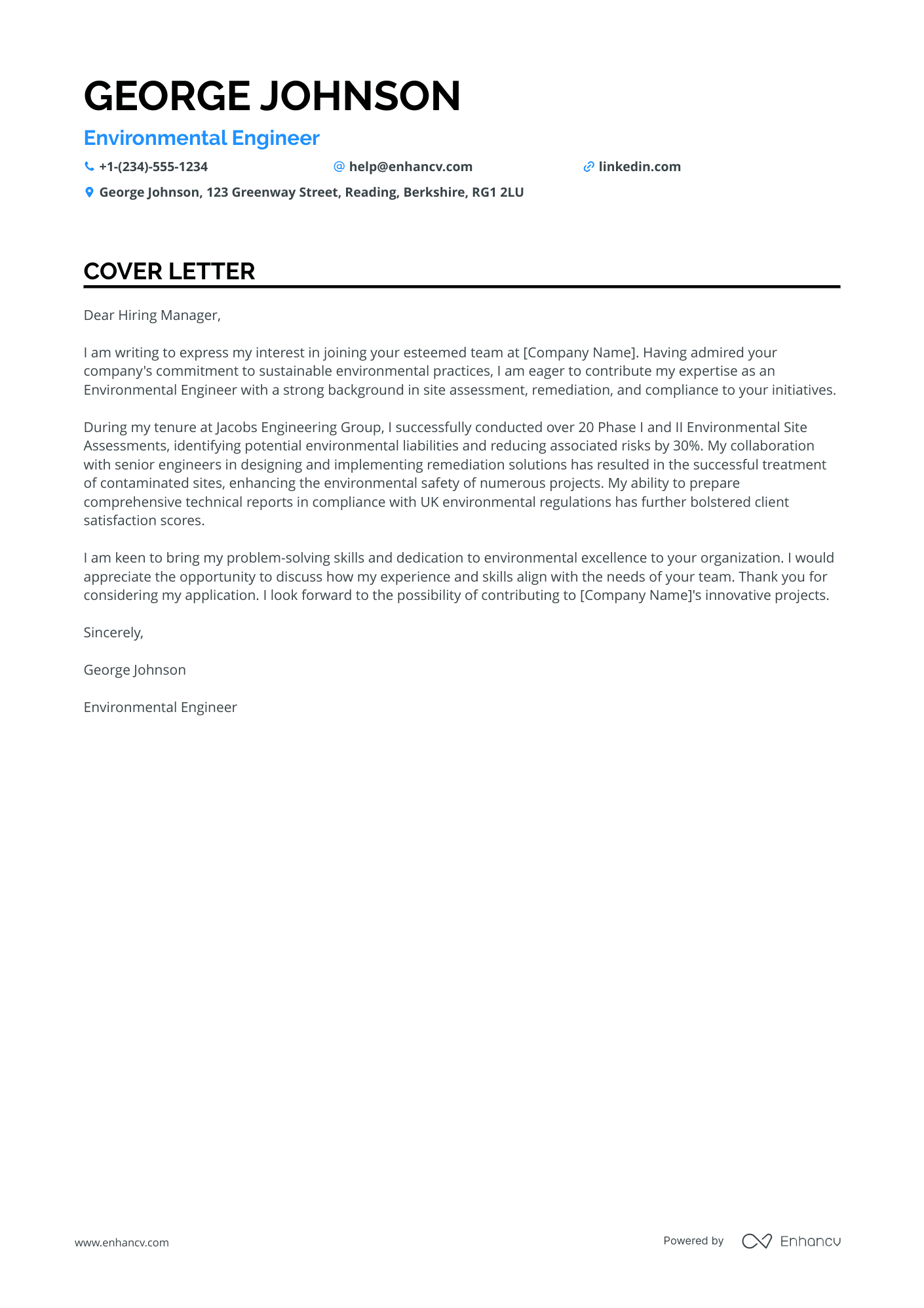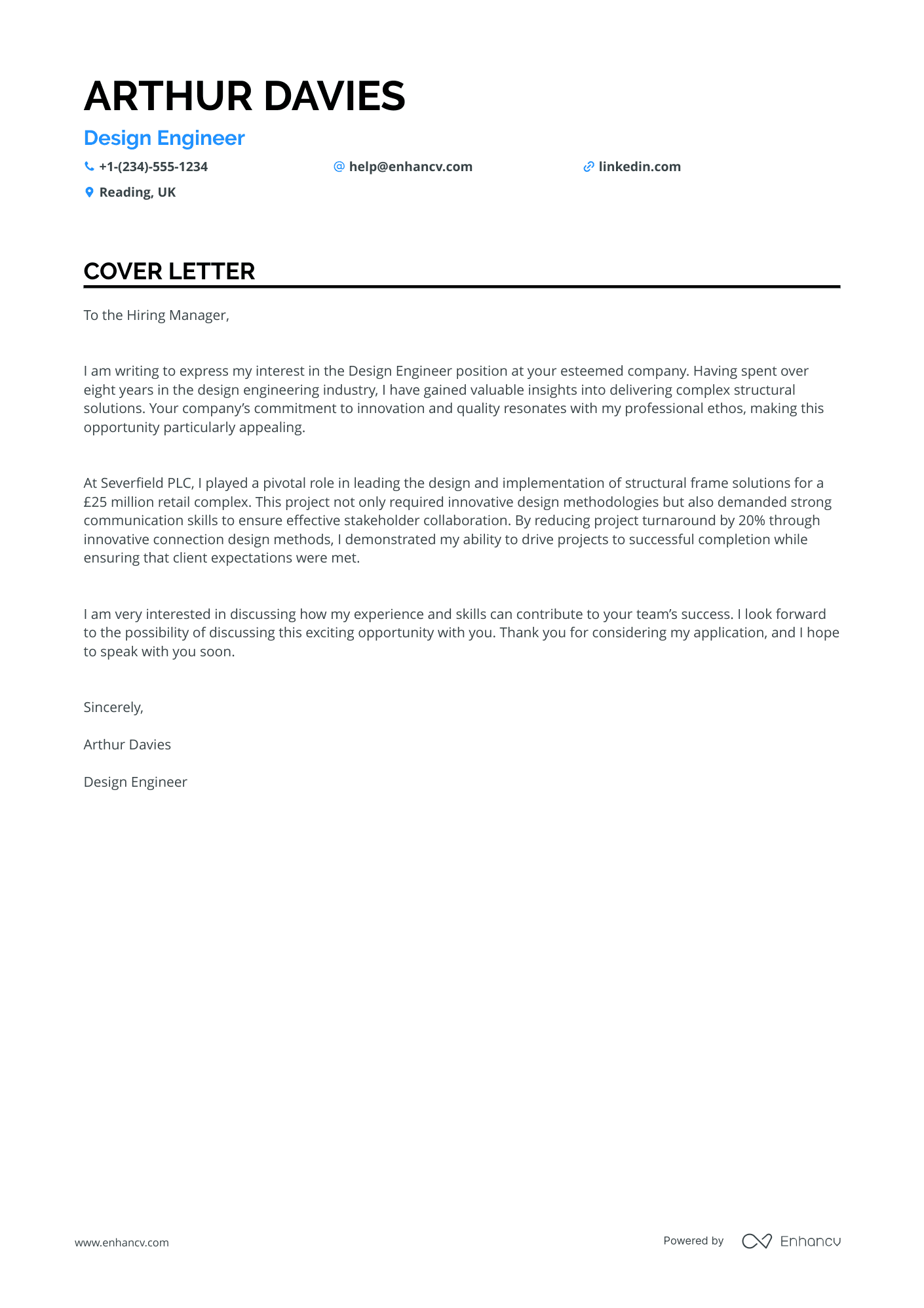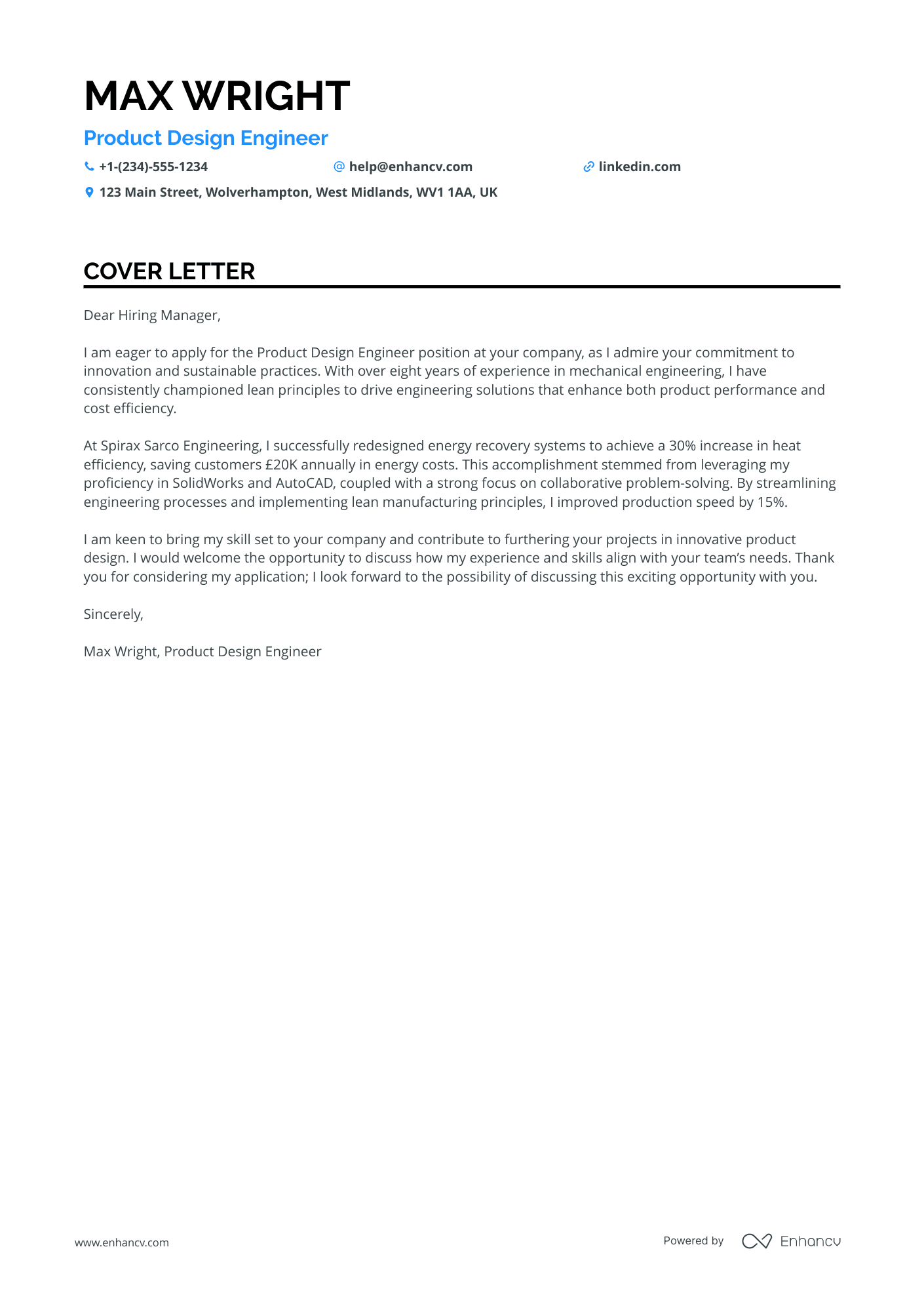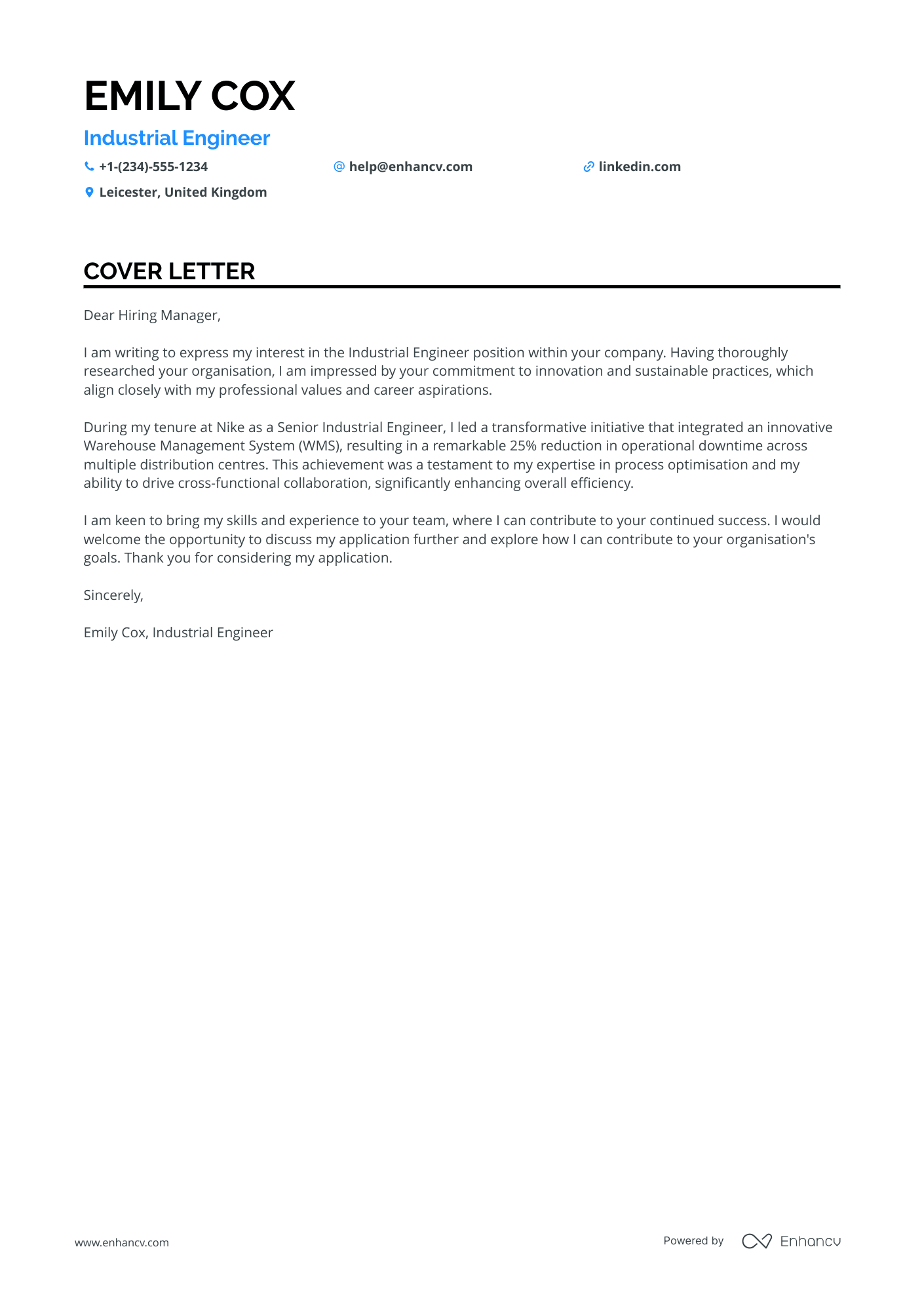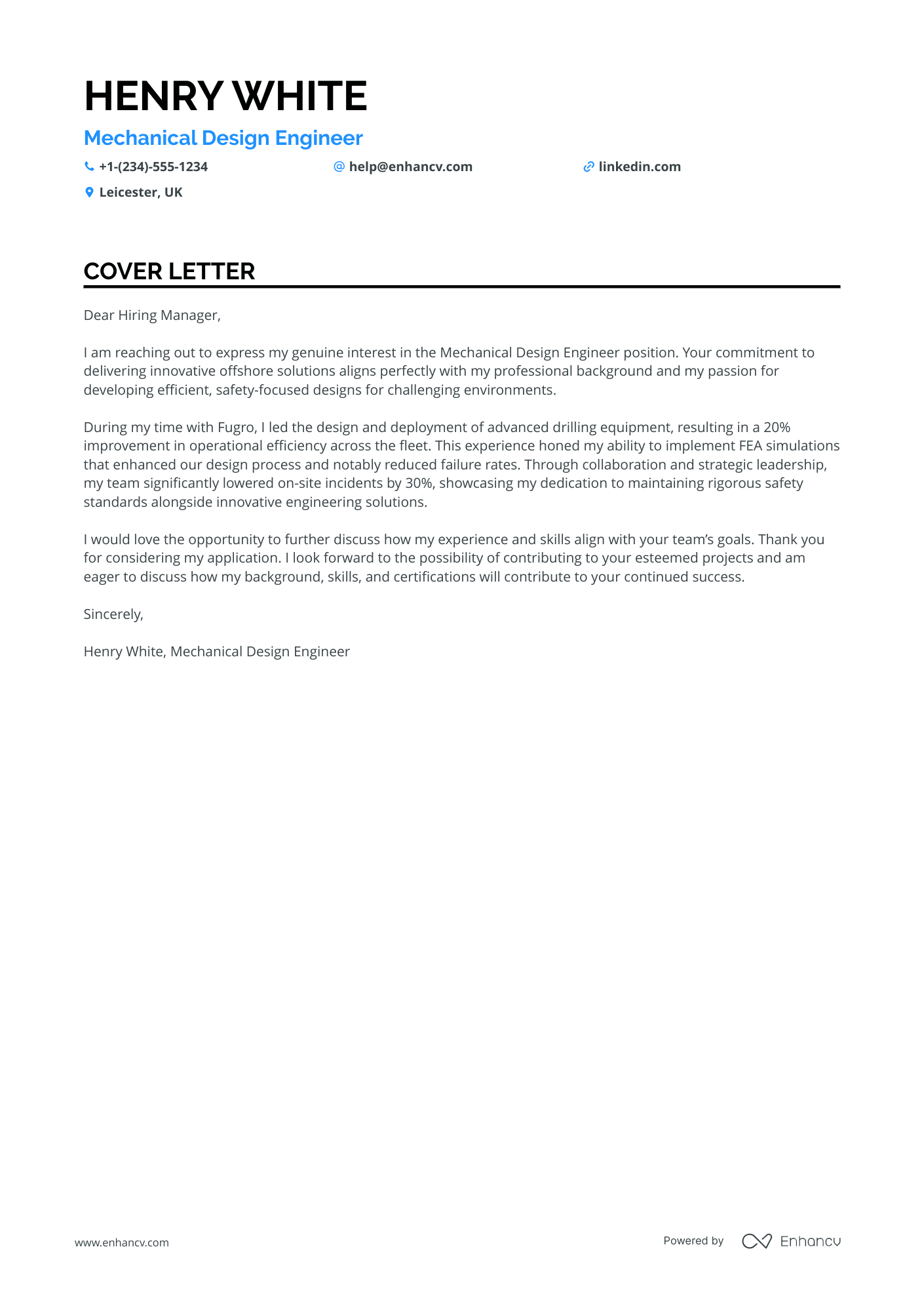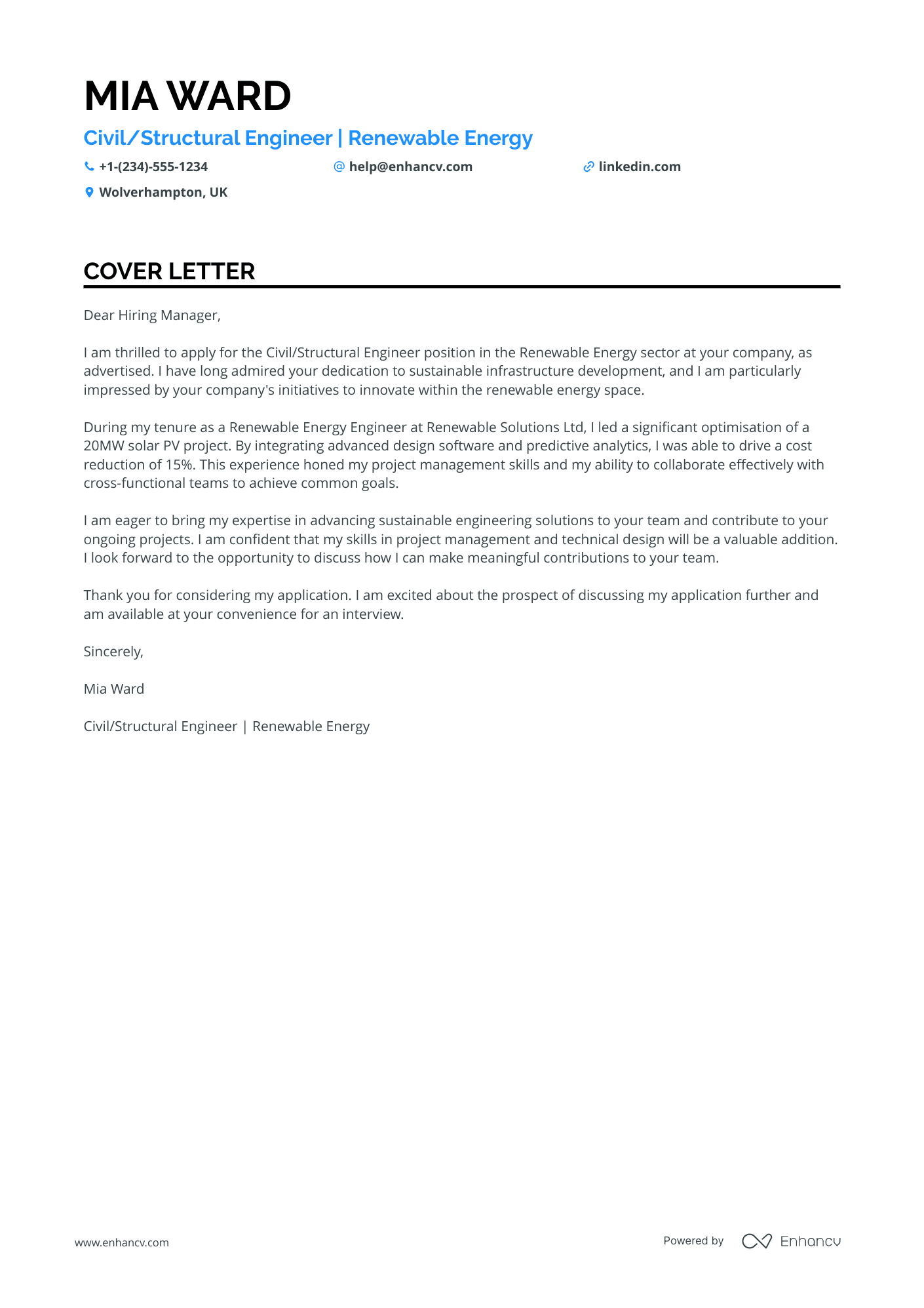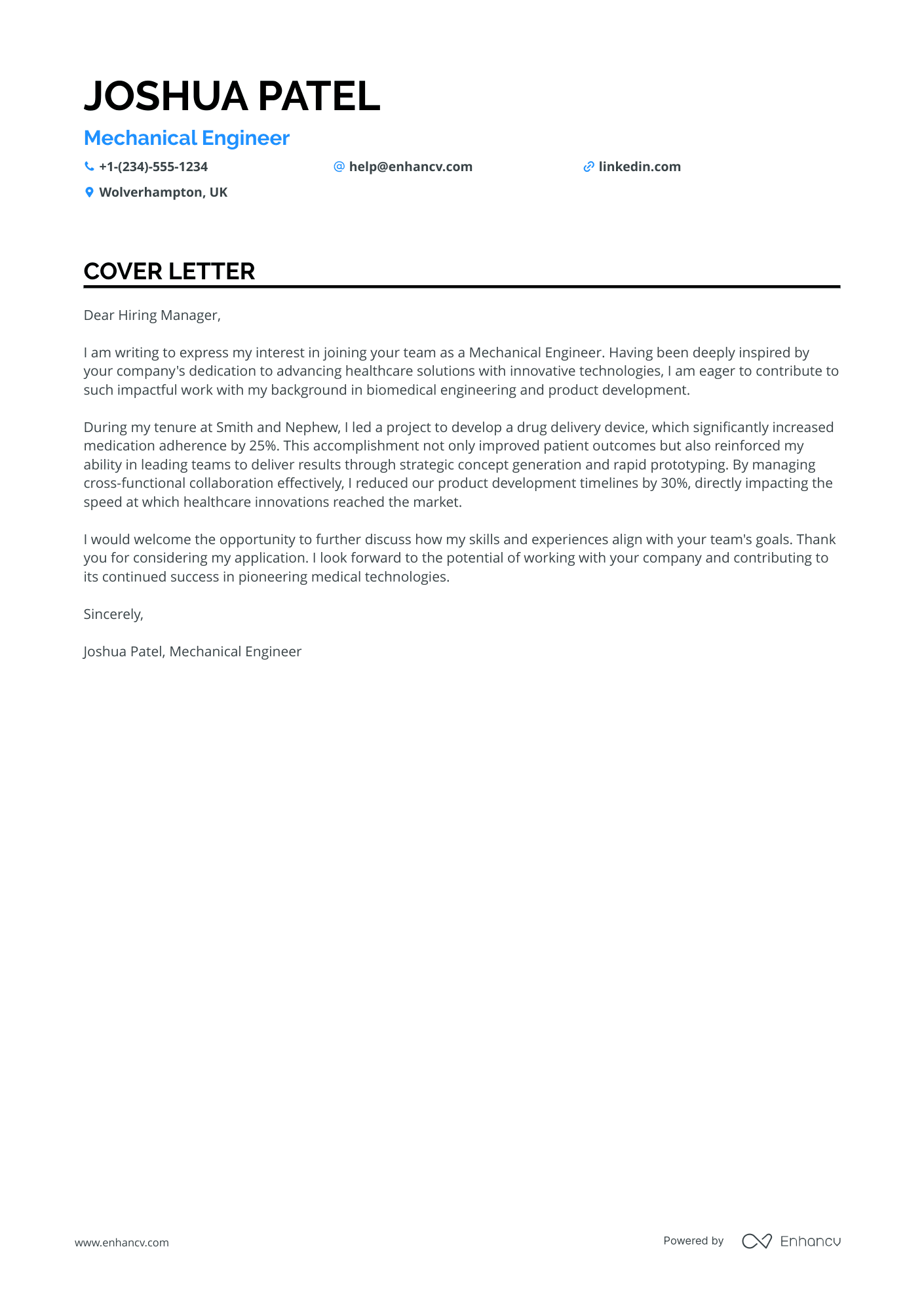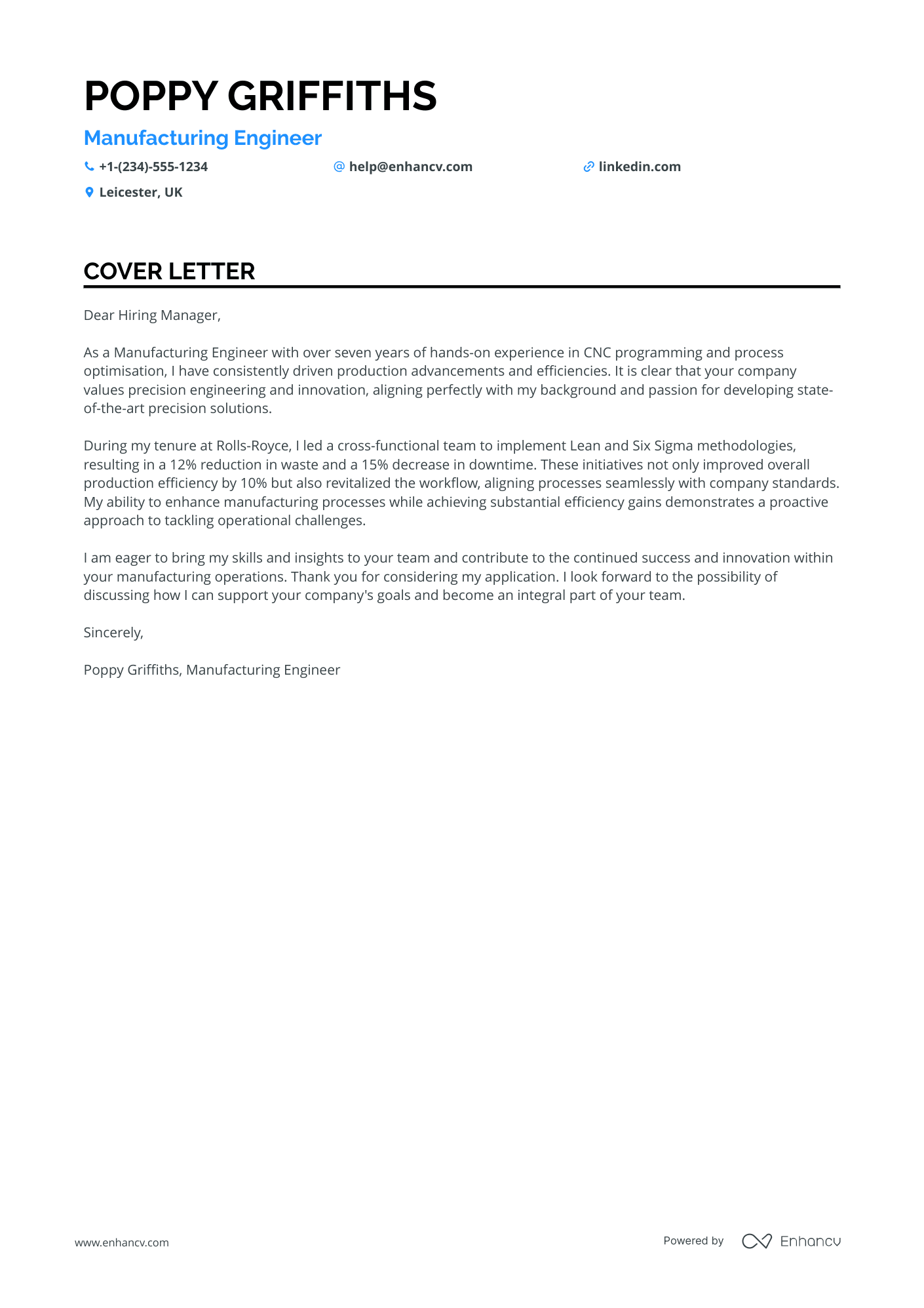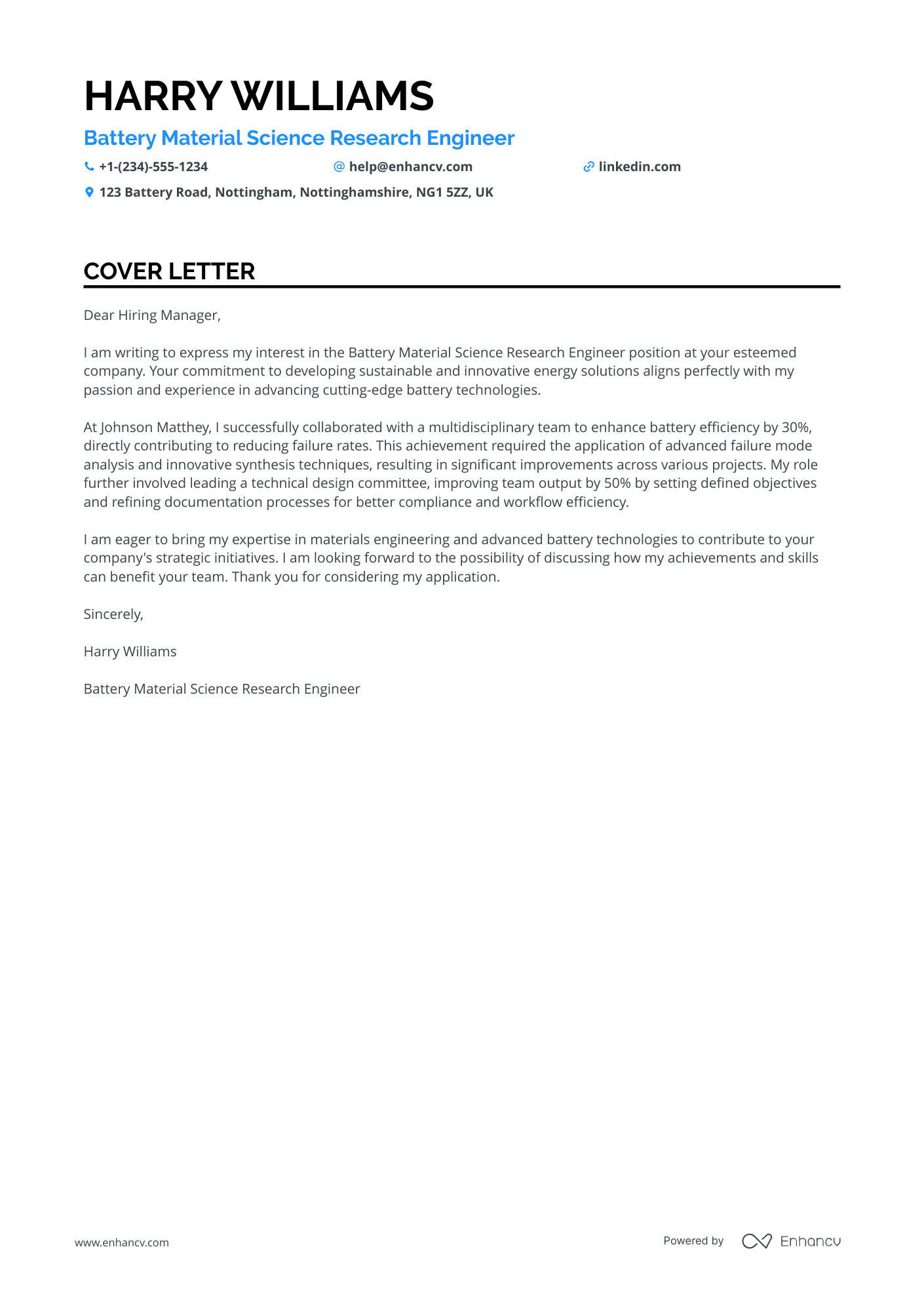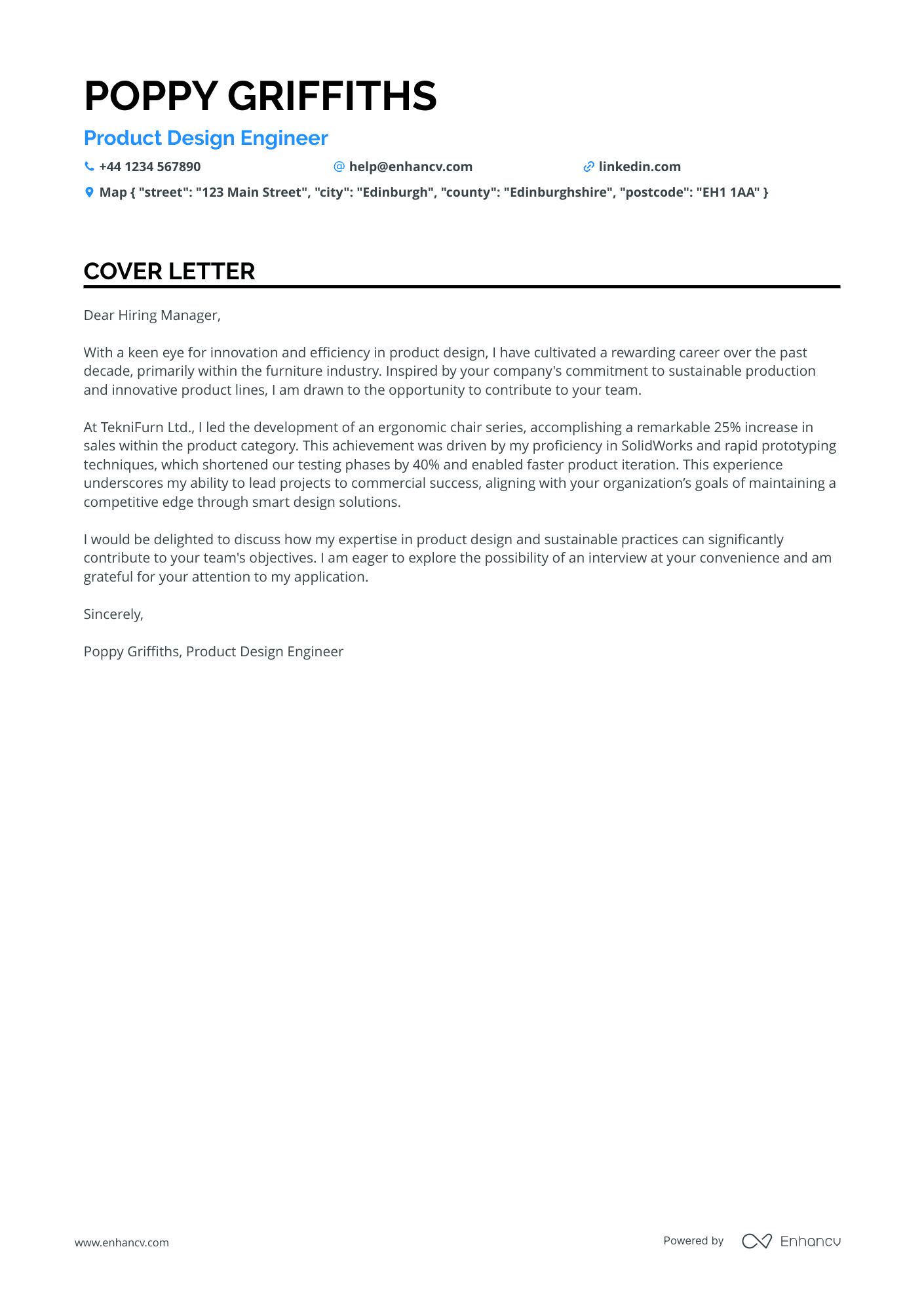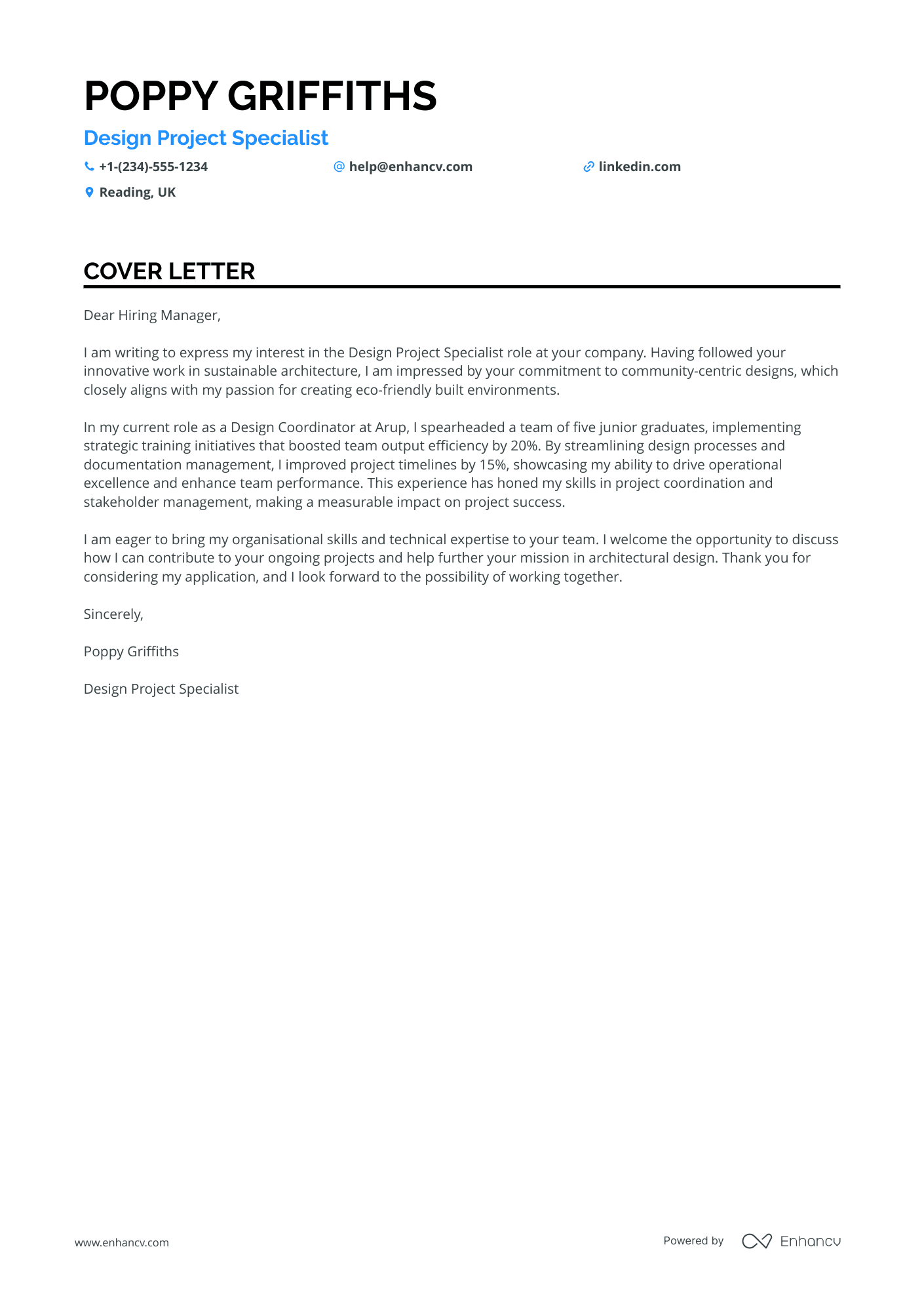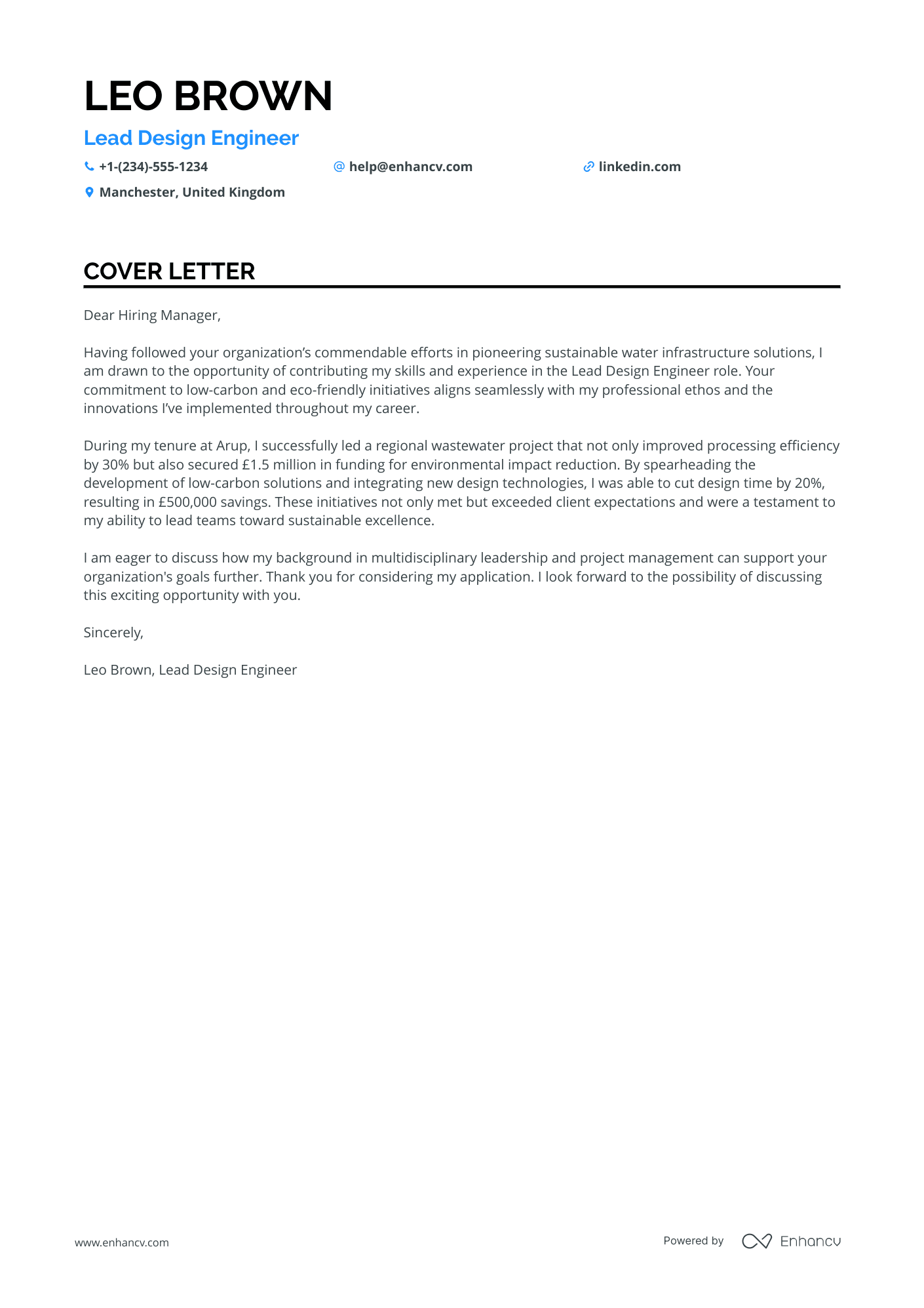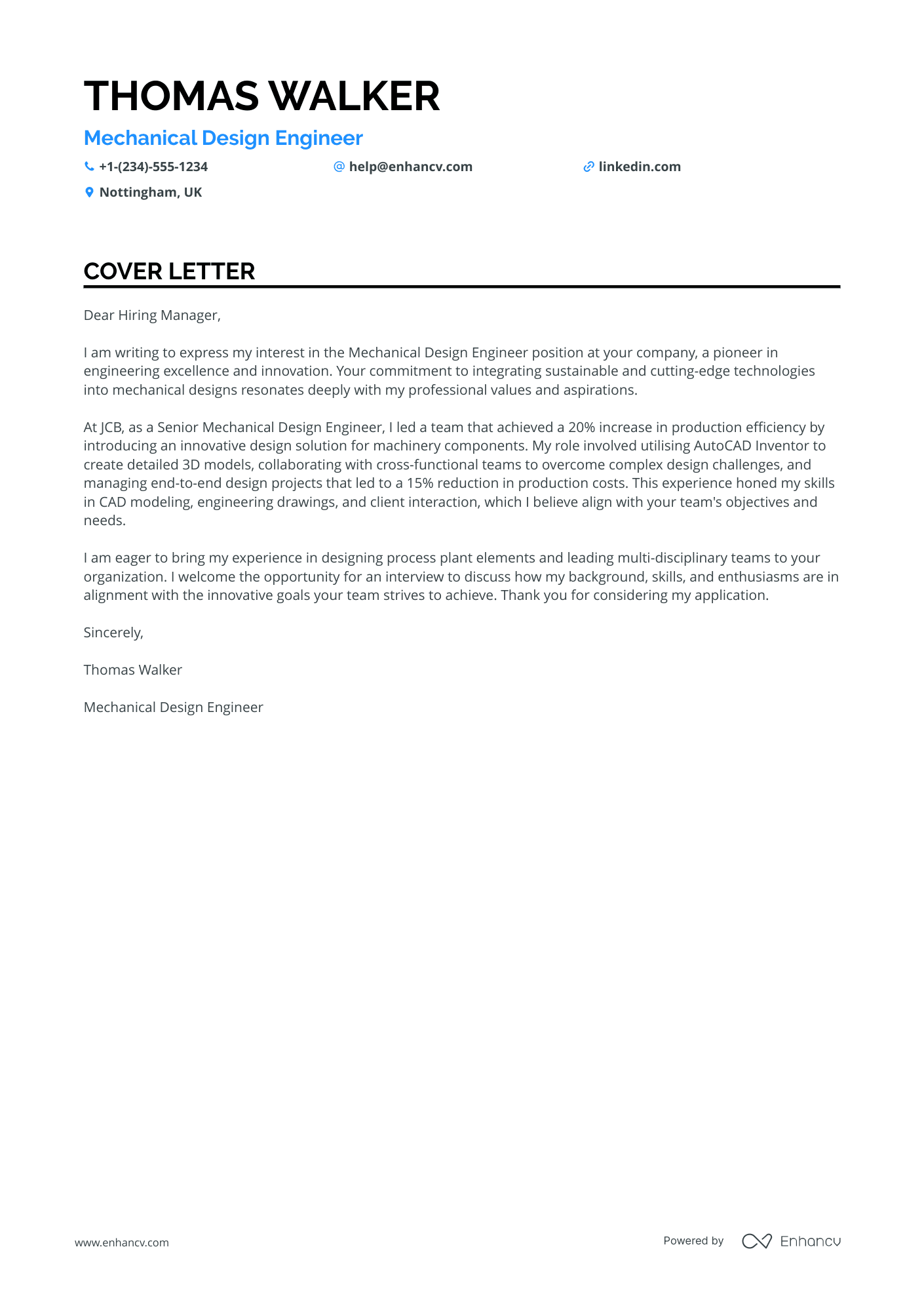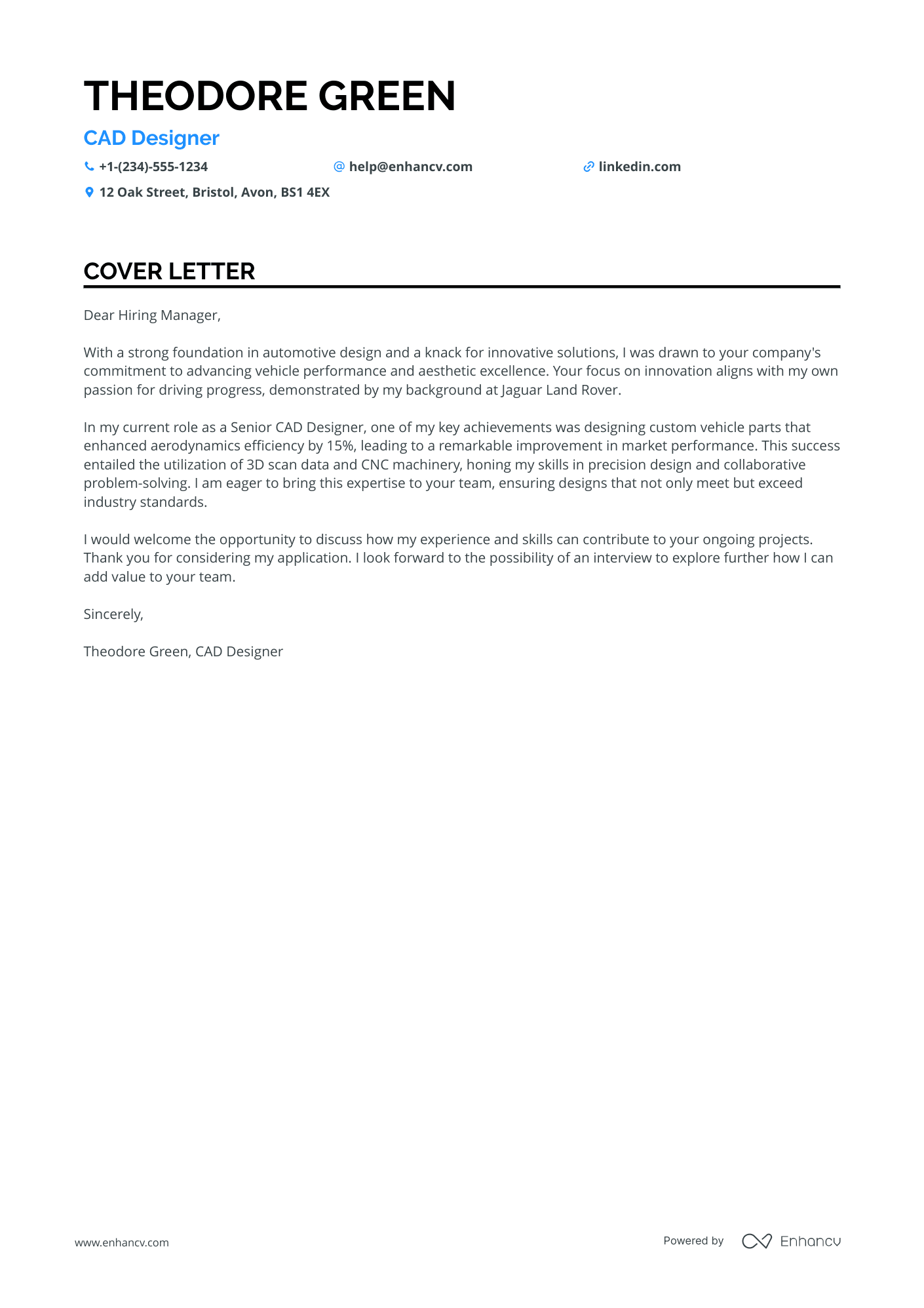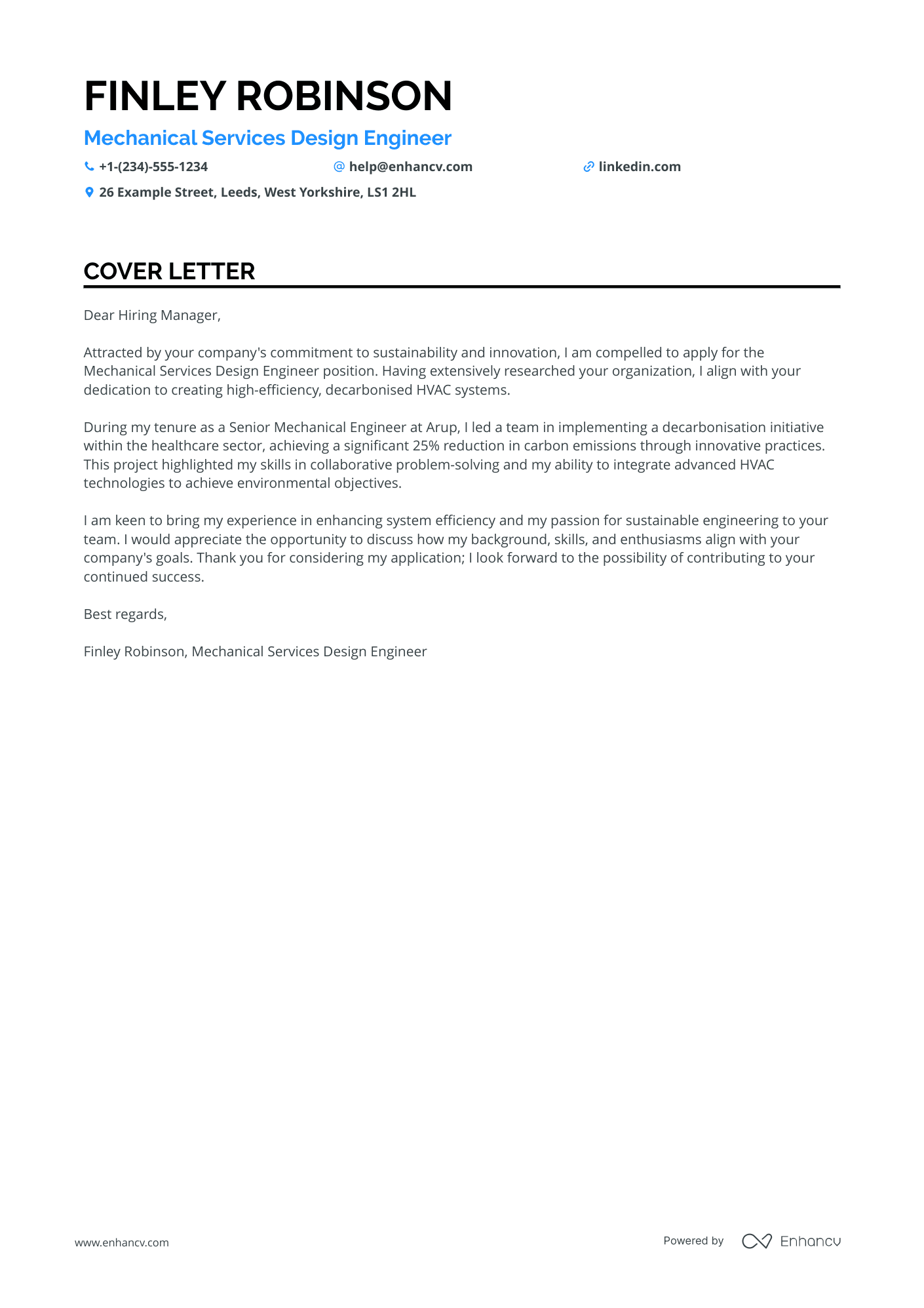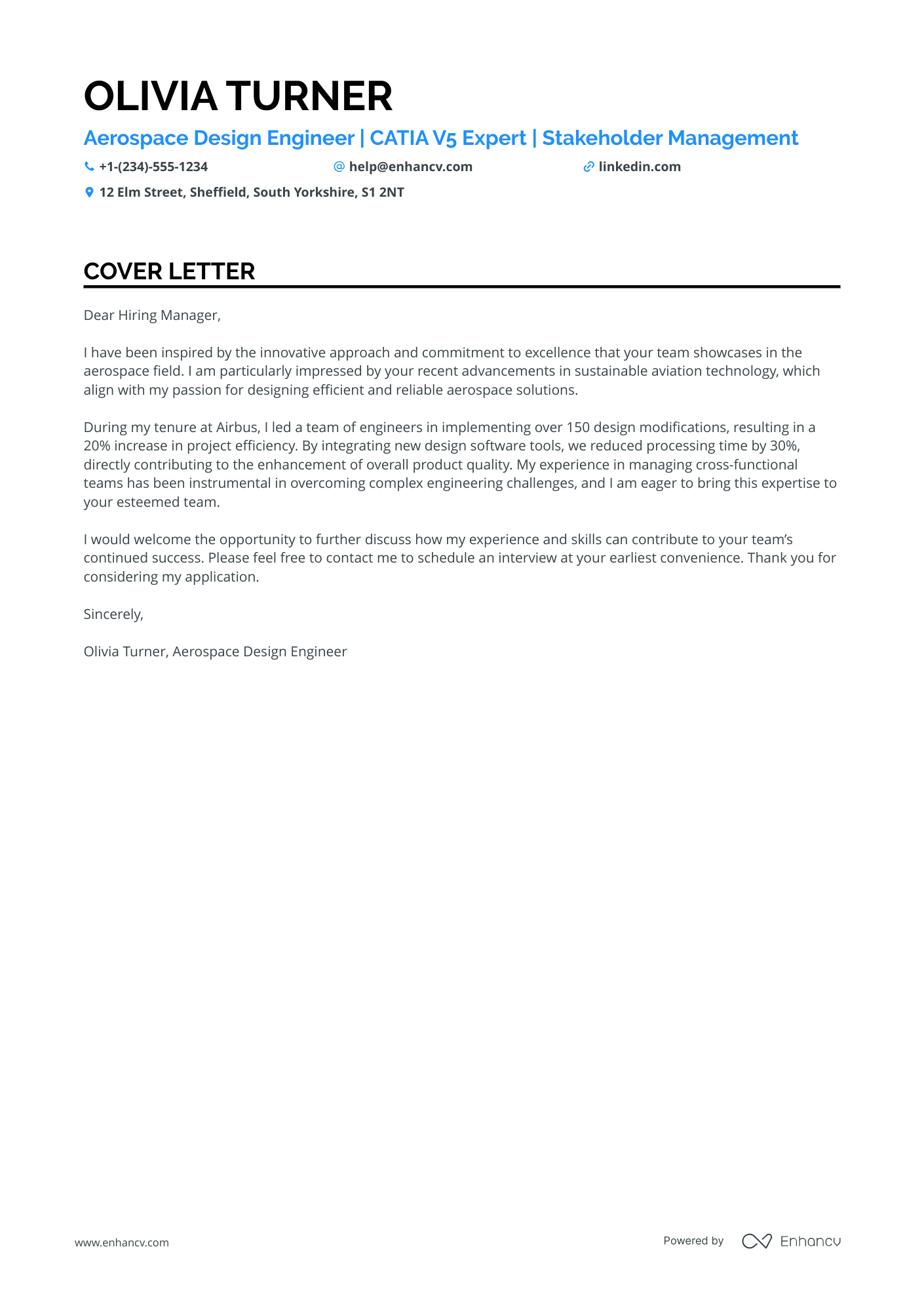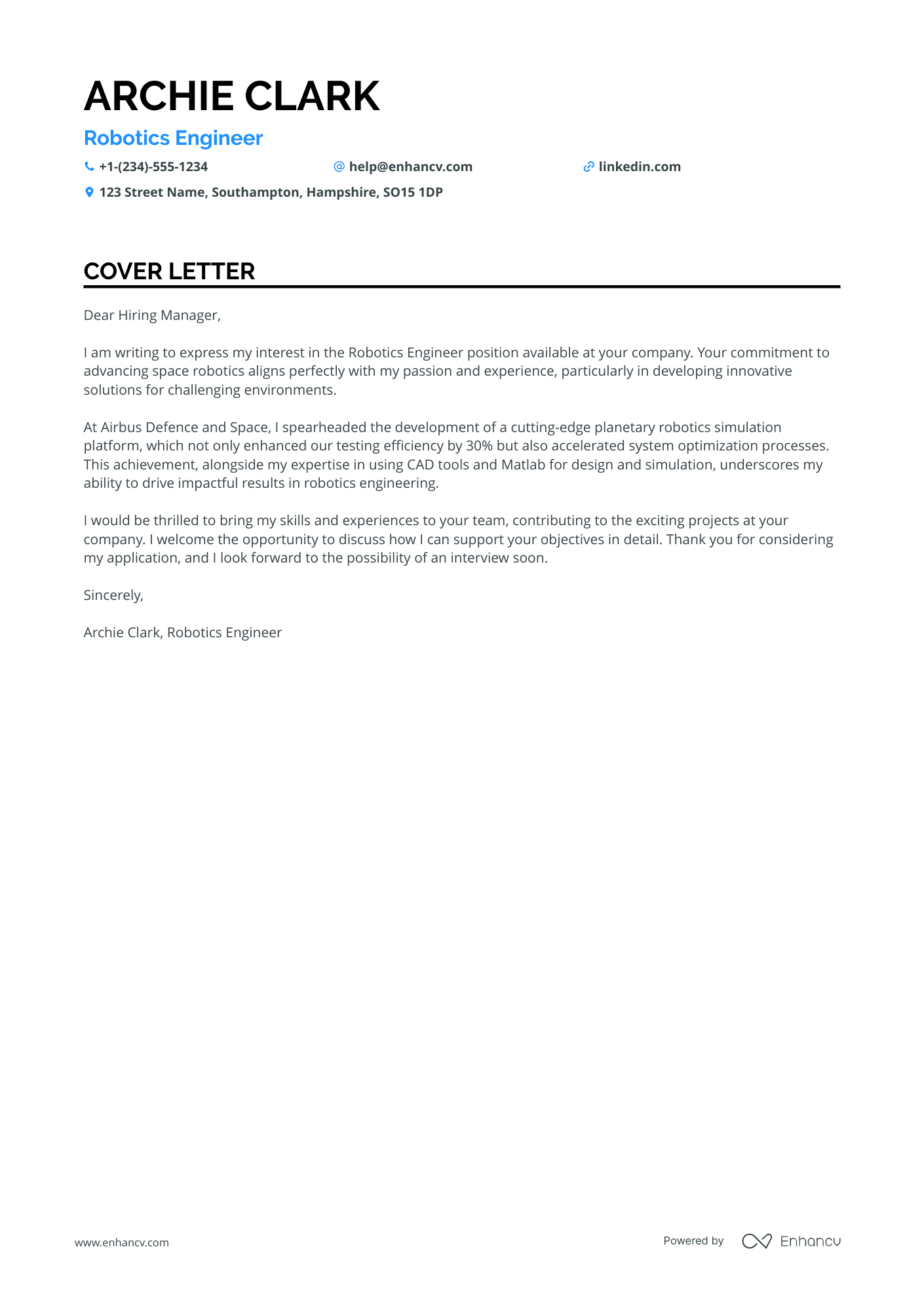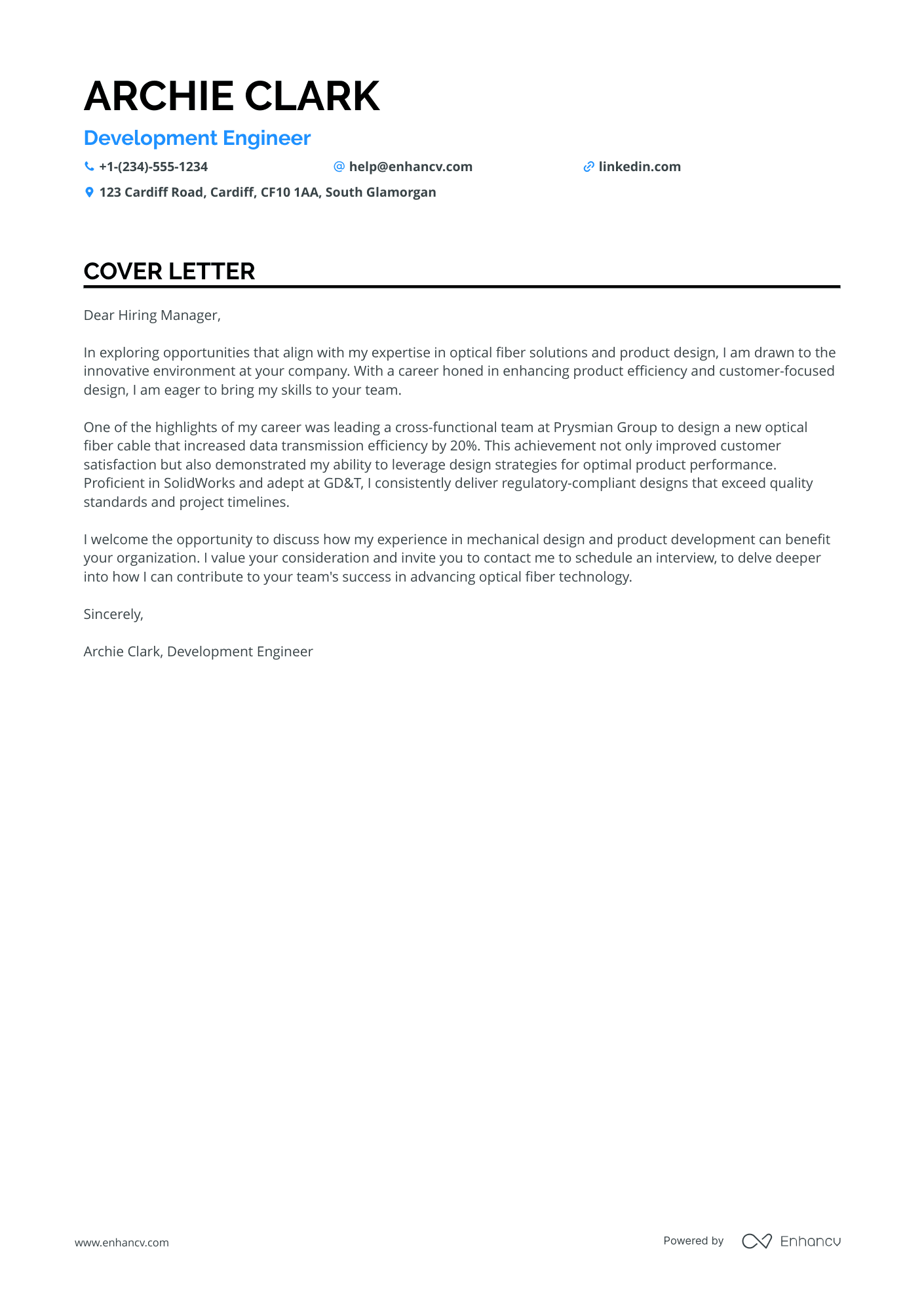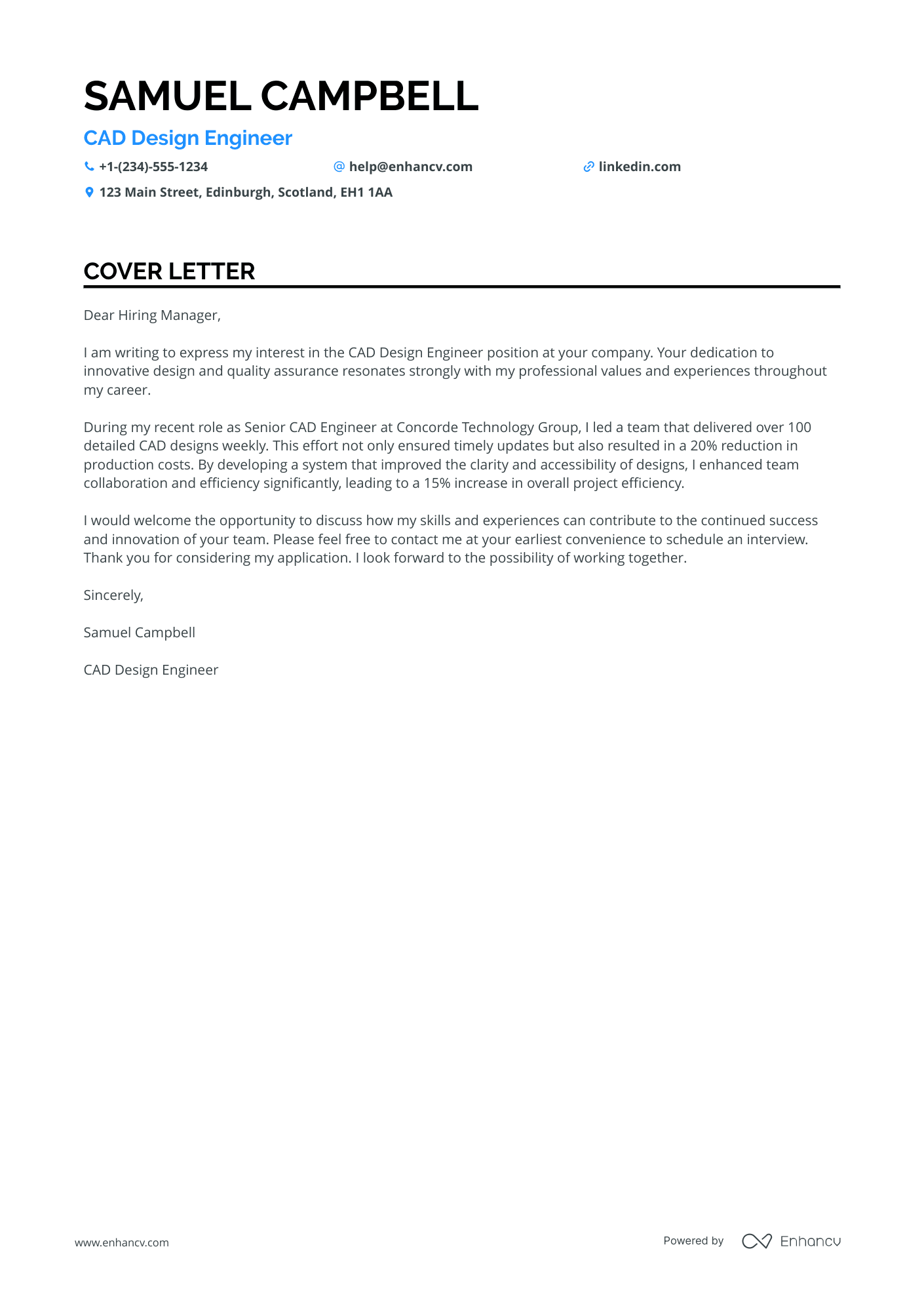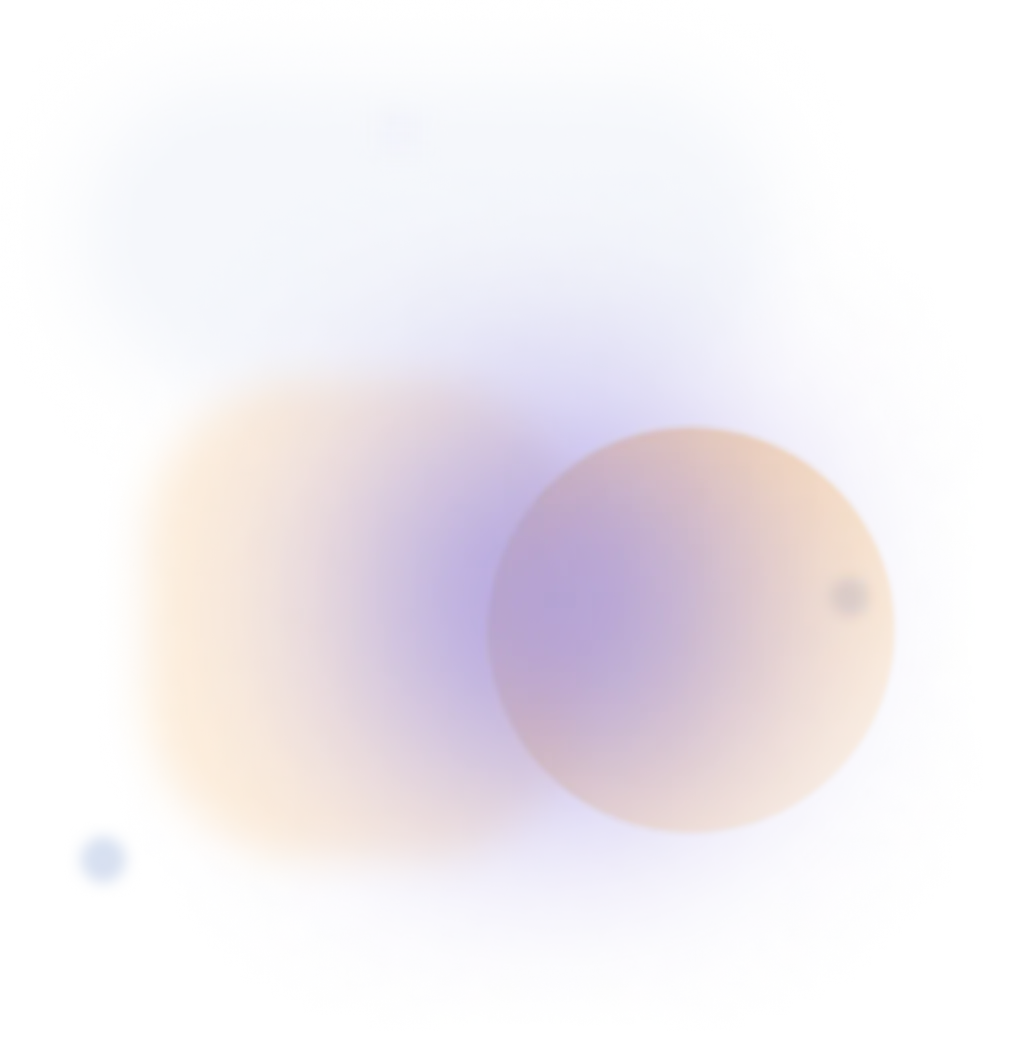Congratulations on completing your first cover letter. However, as you look back, you realise it’s simply a copy-paste of your CV.
Repeating your curriculum vitae is a common pitfall that many candidates encounter, making the cover letter redundant.
Your cover letter should provide fresh insights, adding more value to your application. It’s also the ideal space to address career gaps or major transitions that might not be covered in your CV.
In this guide, you’ll learn how to use your cover letter to demonstrate why you’re the best candidate for the role, while confidently addressing your career history and key achievements.
Cover letter examples for design engineer
By Experience
Senior Electrical Design Engineer
- Highlight the importance of specialised certifications such as "Advanced Data Centre Design" to demonstrate mastery in specific industry applications.
- Emphasise key technical skills relevant to the role, such as "Technical risk assessment" and "Schematic design," showcasing expertise in core areas essential for a Senior Electrical Design Engineer.
- Illustrate substantial achievements and quantifiable improvements, like a 30% increase in project delivery efficiency, to provide a measure of impact and competency.
- Demonstrate effective communication and leadership by mentioning experiences that reduce project delays and enhance stakeholder collaboration.
Junior Structural Design Engineer
- Emphasise Relevant Skills: Highlighting proficiency in AutoCAD and organisational skills directly aligns with the needs of a Design Project Specialist, demonstrating technical and managerial capability.
- Quantify Achievements: Using specific figures, such as a 15% improvement in project timelines, adds substantial credibility and showcases the impact of your previous work experience.
- Leadership and Team Coordination: Detailing experiences in leading a team and enhancing performance by 20% indicates strong leadership and team-building skills, crucial for a Team Coordinator role.
- Industry-Specific Education and Certifications: Mentioning relevant education like a Bachelor of Architecture and industry certifications enhances your credibility and professional development in the architectural field.
Lead Civil Design Engineer
- Emphasising Industry Expertise: Highlighting 10 years of experience in leading multidisciplinary teams and delivering low-carbon, cost-effective water infrastructure projects is crucial in demonstrating industry leadership and expertise for a Lead Design Engineer role.
- Showcasing Achievements: Focusing on tangible outcomes, such as improving performance by over 30% and reducing emissions by 15%, showcases ability to drive significant project success and environmental impact reduction.
- Leadership and Development Skills: Explaining how fostering an empowerment culture led to a 25% improvement in employee engagement can underline strong leadership qualities important for managing and inspiring teams effectively in this position.
- Project Management Success: Illustrating management of cross-functional teams that delivered projects on time and under budget further demonstrates project management capabilities key to this role.
Principal Design Engineer in Electronics
- Specific Experience Highlight: The cover letter efficiently showcases experience in analogue design and power solution integration, crucial for Electronics Design Engineer roles.
- Achievements: Mentions a significant reduction in component failure rates and project costs, which demonstrates the candidate’s ability to effectively solve problems and improve efficiency.
- Educational Background: Spotlights advanced degrees in relevant fields from reputable institutions, adding credibility to technical expertise and showing a strong foundation in electronic engineering.
- Skills and Courses: Lists comprehensive skills and additional courses related to analogue design and power electronics, displaying continuous professional development and a thorough understanding of essential technologies.
Entry-Level Environmental Design Engineer
- Highlighting Relevant Experience: Clearly demonstrating extensive experience in environmental engineering roles, including specific achievements such as reducing environmental liabilities by 30% and obtaining a 95% success rate in regulatory compliance.
- Emphasising Technical Skills: Special attention on technical competencies such as GIS for environmental analysis and advanced data analysis to enhance precision and efficiency in project delivery.
- Showcasing Educational Background: Mentioning advanced educational credentials in Environmental Engineering, signalling a strong foundation and continued learning in the field.
- Detailing Recognised Achievements: Including prestigious awards like the Young Environmentalist of the Year Award to underline recognised and validated contributions to the field.
By Role
Mechanical Design Engineer
- Relevance of Experience: The cover letter effectively aligns Harry's extensive experience in CAD modelling and manufacturing with the job's requirements, emphasising a 20% improvement in production efficiency at JCB as a direct result of innovative design solutions.
- Leadership and Collaboration: Highlighting leadership roles, such as leading a team in mechanical design projects, works well to demonstrate Harry's capability to guide multi-disciplinary teams towards achieving goals and enhancing project delivery timelines.
- Technical Proficiency: The mention of specific software skills like AutoCAD Inventor and familiarity with standards such as PD5500 demonstrates Harry's technical expertise, which is crucial for a Mechanical Design Engineer role.
- Achievements and Impact: By including quantifiable achievements like reducing production costs by 15% and increasing customer satisfaction by 25%, the cover letter successfully underscores Harry's ability to deliver results and contribute positively to the company's success.
Automotive Design Engineer
- The cover letter clearly outlines specialised experience with Fusion 360, demonstrating relevance and expertise in automotive design, a critical component for the CAD Designer role.
- Achievements like the "Innovation in Automotive Design Award" are highlighted, showcasing recognised success within the industry and adding credibility to the candidate's capabilities.
- Previous experience at prestigious automotive companies such as Jaguar Land Rover, Aston Martin, and Bentley Motors emphasises a strong background in the automotive sector, enhancing the candidate's suitability for further roles in similar environments.
- The cover letter effectively mentions relevant educational qualifications in Automotive and Mechanical Engineering, supporting the technical competencies required for a CAD Designer in automotive design.
HVAC Design Engineer
- Distinctive Title: The title "Mechanical Services Design Engineer | HVAC Systems | Decarbonisation" immediately clarifies the candidate's area of expertise, making it highly relevant for employers seeking specialization in HVAC systems and sustainability.
- Certification Emphasis: The inclusion of a "CIBSE HVAC Design Certification" highlights an industry-standard qualification, which is critical for credibility and appeal in roles focusing on HVAC design excellence.
- Results-Driven Achievements: The cover letter emphasises specific and quantifiable achievements, like improving system efficiency by 30% and reducing carbon emissions by 25%, demonstrating the candidate's contributions to meaningful energy savings and environmental impact.
- Leadership and Mentorship: Highlighting the mentorship role underscores leadership skills and the ability to enhance team productivity, which is valuable for senior or team-leading positions.
Aerospace Design Engineer
- Emphasising the specialised expertise in CATIA V5, a crucial tool for aerospace design roles, showcasing the candidate's capacity to handle complex design tasks with precision.
- Highlighting substantial experience managing technical solutions for major aircraft projects, which not only reinforces industry-specific skills but also demonstrates a track record of exceeding client expectations.
- Underscoring achievements like "Engineer of the Year" suggests exceptional performance and recognition within the field, enhancing the candidate's professional credibility.
- Mentioning abilities in stakeholder management indicates strong communication skills, essential for collaborative projects and engaging with various project stakeholders effectively.
Software Design Engineer
- Emphasising leadership and project management skills by highlighting the role played in leading the design and implementation of large-scale structural projects, which is crucial for a Design Engineer position.
- Showcasing specific technical skills such as Structural Frame Design and Connection Design, which are fundamental in demonstrating the candidate's expertise relevant to the structural engineering field.
- Mentioning the successful mentoring of junior engineers not only demonstrates leadership but also a commitment to team development, which is appealing to potential employers seeking candidates with strong interpersonal skills.
- Detailing achievements such as the Structural Innovation Award and cost reduction strategies underscore the candidate's capability in driving technical innovation and efficiency improvements within engineering projects.
Product Design Engineer
- Highlighting professional experience in product design with tangible outcomes, such as achieving a 30% increase in heat efficiency and significant cost reductions, adds credibility and showcases impact.
- Emphasising proficiency in industry-standard tools like SolidWorks and AutoCAD and certifications like the Six Sigma Green Belt underlines technical competency and a focus on continuous professional development.
- Drawing attention to leadership in projects aligning with lean manufacturing principles demonstrates an ability to drive production efficiency and innovation effectively.
- Showcasing education background with advanced degrees in Mechanical Engineering from reputable institutions supports the technical foundation required for a Product Design Engineer.
Design Engineer in Robotics
- Clearly highlights relevant experience: The cover letter effectively details Archie's 8 years of experience and specific roles in space robotics, CAD, and Matlab, which are crucial for a Robotics Engineer position.
- Quantifiable achievements: Includes specific metrics such as a 30% reduction in testing time and a 25% improvement in assembly accuracy, which substantiate Archie's impact and contributions.
- Technical skills and expertise: Lists relevant skills such as Matlab/Simulink, CAD (Solidworks, Inventor), and includes specialised courses, demonstrating continuous learning and adaptation to industry advancements.
- Professional development and leadership: Emphasises Archie's role in training junior engineers and leading projects, indicating leadership capabilities and a commitment to departmental growth.
Telecommunications Design Engineer
- Highlighting specific achievements, such as a 20% increase in data transmission efficiency, showcases the candidate's ability to drive meaningful improvements relevant to the role in optical fibre solutions.
- Citing proficiency in essential skills like SolidWorks and Geometric Dimensioning and Tolerancing (GD&T) signals the candidate's preparedness to tackle specialised product design challenges in the sector.
- Emphasising collaboration and leadership experiences, such as managing cross-functional teams, demonstrates the candidate's capability to manage complex projects and lead teams to successful outcomes.
- Showcasing a commitment to customer-focused innovation and regulatory compliance underscores the candidate's dedication to quality and their understanding of industry expectations.
Industrial Design Engineer
- Emphasise relevant certifications, such as the Advanced Six Sigma Green Belt, which directly aligns with process improvement requirements in industrial engineering roles.
- Highlight specific achievements, like leading a 20% efficiency increase through innovative studies, demonstrating tangible results and expertise in process optimisation.
- Mention collaboration with cross-functional teams to illustrate the ability to work well with diverse groups, crucial for fostering innovation and effective process implementation.
- Detail the application of advanced systems, including WMS and WCS, showcasing technical proficiency necessary for process and distribution management roles.
Marine Design Engineer
- Highlight Relevant Certifications: Mentioning certifications such as "Ansys Certification in Finite Element Analysis" and "Lloyd's Register in marine safety standards and compliance" underlines the candidate's specialised knowledge in high-demand areas, critical for Mechanical Design Engineers working on offshore projects.
- Emphasise Key Achievements: Stating achievements like improving operational efficiency by 20% and reducing incident rates by 30% showcases the candidate’s impact on past projects, demonstrating value to potential employers.
- Demonstrate Relevant Experience: Detailing experience with leading design and deployment efforts, handling international site installations, and managing multi-disciplinary teams fits the duties expected of a senior role in the field.
- Note Specific Skills: Including skills like "FEA," "Project Management," and "Risk Assessment," aligns with the job’s technical requirements, ensuring that the candidate is well-equipped to tackle complex challenges in mechanical design and engineering.
Design Engineer in Renewable Energy
- Highlighting Relevant Experience: It is important to detail specific projects, such as the 20MW solar PV farm and 30MW wind farm, showcasing leadership skills and cost efficiency, which are critical in renewable energy roles.
- Emphasis on Education and Certifications: Noting relevant qualifications, like MSc in Civil Engineering and certification in Advanced Solar PV Systems, directly ties educational background to the specific job sector.
- Proficiency in Technical Skills: Highlighting skills like CAD and ArcGIS, essential tools in structural engineering, indicates readiness to tackle complex design and implementation projects.
- Achievements and Impact: Emphasising quantifiable achievements, such as the reduction of design errors by 25% through CAD integration, provides concrete examples of how contributions have led to success in previous roles.
Design Engineer in Biomedical Devices
- Emphasises experience in mechanical and biomedical engineering, which is crucial for roles in innovative medical technologies.
- Highlights leadership roles, such as leading a team in creating a new drug delivery device; showcasing the ability to manage and inspire teams is valuable for senior engineer roles.
- Demonstrates significant achievements, like the Device Innovation Award, evidencing ability to contribute to industry recognition and business success.
- Includes advanced technical skills, like Rapid Prototyping and CFD, that align with industry demands and project requirements for a mechanical engineer.
Design Engineer in Construction
- Emphasise relevant skills and expertise, such as CAD proficiency and BOM management, to showcase technical capabilities critical for a CAD Design Engineer role.
- Highlight achievements, such as leading a team to enhance efficiency or designing protocols to reduce manufacturing costs, demonstrating impact and value added to previous employers.
- Mention any specialised courses or certifications, such as Advanced CAD Techniques or Materials Engineering Certification, to illustrate a commitment to continuous learning and staying current with industry advancements.
- Integrate passions like Sustainable Design, which align with the role and can provide additional insight into the applicant's motivations and potential contributions to the employer's goals.
Design Engineer in Manufacturing
- The cover letter effectively highlights specialised certifications such as the LEAN and Six Sigma Green Belt Certification and Advanced CNC Programming, which are crucial for the role of a Manufacturing Engineer focusing on process optimisation and efficiency improvement.
- The emphasis on systematic process improvements and metrics-driven achievements, like a 25% increase in production efficiency and a 12% reduction in waste, illustrates the candidate's impact in past roles, making it highly relevant for a position seeking optimisation skills.
- Incorporating specific technical skills like CNC Programming, 3D CAD/CAM, and Geometric Dimensioning and Tolerancing (GD&T) aligns with the core responsibilities of a Manufacturing Engineer, showcasing the candidate's readiness to meet the technical demands of the role.
- References to cross-functional collaboration and leadership in Lean and Six Sigma initiatives demonstrate the candidate's ability to work effectively in teams and lead projects, a valuable aspect for engineering roles focused on efficiency and innovation.
Design Engineer in Material Science
- Emphasise relevant experience in battery material science and advanced failure mode analysis, showcasing significant achievements such as enhancing battery efficiency by 30%.
- Highlight leadership roles and teamwork abilities, demonstrated through leading technical design committees and mentoring peers, resulting in improved team output and technical proficiency.
- Showcase certifications and education pertinent to the role, such as a Master’s in Materials Engineering and an Advanced Battery Technologies Certification, establishing credibility and specialised knowledge.
- Illustrate skills in project management and inter-departmental collaboration, enhancing project completion rates and expanding business into new markets, essential for strategic growth in energy storage sectors.
Design Engineer cover letter example
Poppy Griffiths
[object Object]
+44 1234 567890
help@enhancv.com
- Emphasize Key Skills: Highlight specific skills that are critical for the role, such as proficiency in SolidWorks and rapid prototyping techniques, to demonstrate technical expertise and value to potential employers.
- Showcase Achievements: Include quantifiable achievements, such as leading the development of a product series that resulted in a significant increase in sales, to provide evidence of past successes and effectiveness in driving results.
- Align With Company Values: Express a genuine interest in the company by mentioning shared values, such as a commitment to sustainable practices, to show alignment and compatibility with the company culture.
- Express Eagerness: Convey eagerness and flexibility for an interview to demonstrate motivation and willingness to contribute to the company's goals.
Importance of cover letters in the United Kingdom
A well-crafted cover letter can significantly strengthen your job application by emphasising why you’re an ideal fit.
Here are some reasons why it matters:
- Personalisation: Employers expect your cover letter to demonstrate how your skills and experience align with the company’s needs and/or values.
- Addresses what is omitted from your CV: If your career path includes gaps or changes, your cover letter is the best place to address these positively and explain their relevance.
- Opportunity to stand out: Many applicants have similar qualifications, so a tailored cover letter can show your unique attributes and experience.
What UK employers expect from a cover letter
Your UK employers will appreciate your application if you've taken the effort to tailor your cover letter to their job requirements.
Here’s how to ensure yours ticks all the right boxes:
- Research the company thoroughly: It's not enough to have only read the job advert. Look into the company's history, products, services, and recent achievements to demonstrate your genuine interest and knowledge.
- Connect with the company’s values: Every company has core principles that shape its culture and operations. Identify these values and use your cover letter to show how they align with your professional conduct and ethics.
- Emphasise your relevant skills: Highlight specific skills that match the job description and are most in demand. Use examples from your previous experience to support your claims and set yourself apart from other candidates.
How to format a design engineer cover letter
Your cover letter is your opportunity to make a strong impression, so its structure must be professional and clear.
Here's an overview of how a UK cover letter should be structured:
- Begin with your address and contact details at the top.
- Include the employer’s name and address directly below.
- Add the date to the left or right of the page.
- Use an appropriate greeting, such as 'Dear Mr Smith' or 'Dear Sir/Madam.'
- Open with a strong introductory paragraph.
- Develop your points in the middle paragraphs, focusing on relevant skills and experience.
- Close with a concise conclusion, reiterating your interest and suitability for the role.
- Sign off formally with your name and signature.
The software used to match your profile to the job, Applicant Tracking Systems (ATS), won’t scan your cover letter. Instead, the cover letter reads as a more personalised note to the recruiter.
When it comes to choosing a font, consider modern options like Lato, Rubik, or Chivo, which should also be applied to your CV to maintain a consistent appearance.
Additionally, your cover letter should be single-spaced with 1-inch (2.5 cm) margins on all sides (our templates are pre-set with these specifications so you can focus on your cover letter content).
Finally, always send your cover letter as a PDF to preserve the formatting and prevent edits.
How to write your design engineer cover letter salutation
Now it's time to make it personal—in your cover letter greeting, you should always address the hiring manager directly. Whenever possible, use their name, depending on how well you know them (e.g., 'Dear Mr Smith', 'Dear Abbie').
You can find their name by searching on LinkedIn (start by looking for the job posting and the recruiter), visiting the 'About' page of the company's website, or by calling reception or administration to enquire.
How to write your design engineer cover letter intro
One of the best ways to grab a hiring manager's attention? Show them the unique value you'd add to the team.
Review the skills or requirements listed in the posting and draw connections to your previous work experiences.
Focus on specific (and quantifiable) accomplishments and qualifications that align with the job description to make a strong first impression.
How to write your design engineer cover letter body
As you reach the body of your cover letter, you might wonder what to write in it.
Our advice? Don’t just copy your CV—choose your greatest achievement and tell its story.
Focus on how you got there using hard and soft skills, describe your involvement, and quantify the results with concrete outcomes.
Remember, recruiters aren’t looking for an epic tale of your career—they want something concise, relevant, and directly addressing their needs.
How to write a closing paragraph
There’s a wrong and a right way to close your cover letter. Here’s how.
The wrong way is to end with a signature or a formal 'Thank you in advance.'
The right way is to either promise how you’d make a positive impact on the company or ask when you can expect a response. This will highlight you as a forward-thinking candidate who’s enthusiastic about securing the role.
Conclusion
Your cover letter is an opportunity to showcase your personality and skills to potential employers. Start by addressing the hiring manager by name and tailoring your content to reflect the role’s requirements.
Include a specific example of your greatest achievement to illustrate your suitability for the position, while also expressing your enthusiasm for the company. Remember to format your letter professionally, ensuring it aligns seamlessly with your CV.
